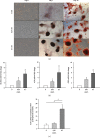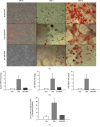Insulin Enhances the In Vitro Osteogenic Capacity of Flexor Tendon-Derived Progenitor Cells
- PMID: 31949435
- PMCID: PMC6948345
- DOI: 10.1155/2019/1602751
Insulin Enhances the In Vitro Osteogenic Capacity of Flexor Tendon-Derived Progenitor Cells
Abstract
There is increased incidence of tendon disorders and decreased tendon healing capacity in people with diabetes mellitus (DM). Recent studies have also suggested pathological ossification in repair tendon of people with DM. Therefore, the objective of this study is to investigate the effects of insulin supplementation, an important pathophysiologic stimulus of DM, on tendon progenitor cell (TPC) proliferation and in vitro osteogenic capacity. Passage 3 TPCs were isolated from collagenase-digested, equine superficial digital flexor tendons. TPC proliferation was measured via MTT assay after 3 days of monolayer culture in medium supplemented with 0, 0.007, 0.07, and 0.7 nM insulin. In vitro osteogenic capacity of TPCs (Alizarin Red staining, osteogenic mRNA expression, and alkaline phosphatase bioactivity) was assessed with 0, 0.07, and 0.7 nM insulin-supplemented osteogenic induction medium. Insulin (0.7 nM) significantly increased TPC proliferation after 3 days of monolayer culture. Alizarin Red staining of insulin-treated TPC osteogenic cultures demonstrated robust cell aggregation and mineralized matrix secretion, in a dose-dependent manner. Runx2, alkaline phosphatase, and Osteonectin mRNA and alkaline phosphatase bioactivity of insulin-treated TPC cultures were significantly higher at day 14 of osteogenesis compared to untreated controls. Addition of picropodophyllin (PPP), a selective IGF-I receptor inhibitor, mitigated the increased osteogenic capacity of TPCs, indicating that IGF-I signaling plays an important role. Our findings indicate that hyperinsulinemia may alter TPC phenotype and subsequently impact the quality of repair tendon tissue.
Copyright © 2019 Sushmitha S. Durgam et al.
Conflict of interest statement
The authors declare that they have no conflicts of interest.
Figures




References
-
- Gajhede-Knudsen M., Ekstrand J., Magnusson H., Maffulli N. Recurrence of Achilles tendon injuries in elite male football players is more common after early return to play: an 11-year follow-up of the UEFA Champions League injury study. British Journal of Sports Medicine. 2013;47(12):763–768. doi: 10.1136/bjsports-2013-092271. - DOI - PubMed
-
- Smith R. K. W., Birch H. L., Goodman S., Heinegård D., Goodship A. E. The influence of ageing and exercise on tendon growth and degeneration-- hypotheses for the initiation and prevention of strain-induced tendinopathies. Comparative Biochemistry and Physiology. Part A, Molecular & Integrative Physiology. 2002;133(4):1039–1050. doi: 10.1016/S1095-6433(02)00148-4. - DOI - PubMed
LinkOut - more resources
Full Text Sources

